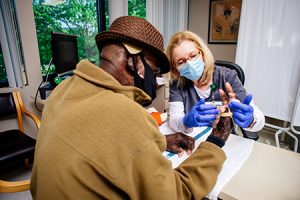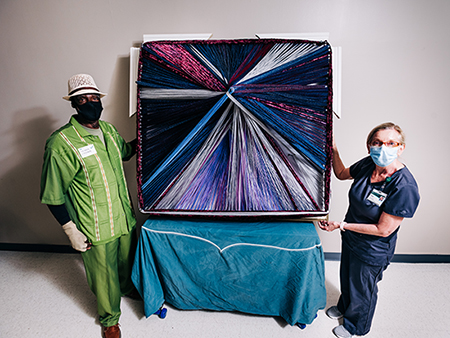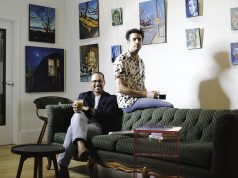By Shannon Thomason
UAB News
To create his works of art, Delrico Gibson must be able to grip and hammer each nail into the wood. He must pull the strings, wrap them tightly, make knots and cut the excess thread.
A year ago, he could not move his fingers.
After a devastating, life-changing accident, Gibson thought he might never be able to use his hands again.
“If you had put a feather on the floor and offered me a million dollars to pick it up, I wouldn’t have been able to,” Gibson said.
Not only did the physicians, therapists and health care workers at the University of Alabama at Birmingham save his life — they helped him recover the ability to eat again, make art again. They helped him find hope.
“You know the story of Humpty Dumpty — they put me back together,” he said. “I am so grateful for them. And I was messed up really, really bad.”
The Fire
On Feb. 29, 2020, Gibson had been prepping to smoke meat for his family’s new soul food restaurant in Clanton, Alabama. A chef by trade, and living in Oakland, California, he retired and moved to Alabama. The restaurant had been open just 18 days.
Out of lighter fluid, he used a little gasoline to get the fire started. However, he made a mistake that cost him dearly: He added gasoline to the weakly burning blaze. The boom of the explosion knocked him to the floor and blew gas out onto him.
“I was on fire. I was burning,” Gibson said. “I was literally burning up.”
Gibson called out to God and, in those few seconds, heard a voice telling him to trust him. From that point on, he felt no pain, Gibson says. His sons helped extinguish the fire and called 9-1-1. Emergency medical responders drove him and his wife, Jacquelyne, up the interstate to UAB Hospital. That is the last thing he remembers.
Gibson woke up from a medically induced coma 37 days later, on April 6. The fire had been so hot that it literally reshaped some of the bones in his arms and hands. But he was alive.
Gibson said it has taken multiple surgeries to “get close to normal again.” The burn surgeons at UAB saved his life, says plastic surgeon René Pierre Myers, M.D., an assistant professor in the UAB School of Medicine’s Division of Plastic Surgery, who has operated on Gibson’s hands.
James Hwang, M.D., director of UAB Medicine’s Burn Center, used skin from Gibson’s thighs as a graft for his arms, hands and fingers. One of Gibson’s arms has only 30 percent mobility, fused in that position after the fire melted it. He will never be able to bend his thumbs or index finger again. Gibson has several other procedures on his hands pending.
When Gibson developed microstomia — often a consequence of facial burns — Myers connected him with Michael Kase, DMD, with the UAB School of Dentistry and Oral and Maxillofacial Surgery. Gibson did not want to have surgery and a feeding tube placed, so Kase recommended the doctors and therapists who made tools to gradually stretch Gibson’s mouth open again. Gibson could tolerate the apparatus in his mouth for only a few minutes to start, and slowly worked up to wearing it eight hours a day.
When Gibson speaks Myers’ name, he murmurs, “Lord bless that man to continue what he does, hallelujah.”
“I said, ‘Doc, I need my hands, man,’” said Gibson, who is originally from the East Side of Detroit, Michigan. “I have talents, and one of my talents is making pictures. Art — symmetric abstract design string art: It’s what I do. My artwork inspires a lot of people, just like I have been inspired.”
Myers introduced him to a therapist for his hands, too.
“Our goal is function,” Myers said. “As plastic surgeons, we can alter anatomy; but the real heroes here are the therapists who help patients work back to functionality.”

Therapy Works
Diane Coleman is a therapist in the Hand Therapy Clinic of UAB’s Hand and Upper Extremities Services, and when Gibson speaks her name, it has a special reverence.
He says Coleman told him, “You are gonna have a lot of work to do to get there; but if you do like I ask you to do, I am telling you, you’ll get better.” She gave him exercises to do at home, and he did them. He started seeing progress. “This lady, man, she knows what she is doing,” Gibson said to himself.
“Coming to therapy once a week won’t cut it — what he does every day, four or five times a day, is what is going to make the difference,” Coleman said. Gibson used his therapy tools so much he wore them out, and she had to constantly replace them.
“It’s very impressive to have a patient like that, who is very dedicated to his own rehab, versus us who are kind of coaching, being on top of patients and saying ‘you gotta do this to get there’ — he absorbed it and just went for it,” Coleman said.
Gibson also inspires other patients in the clinic, talking with them about his injuries and telling them they need to do their exercises, they need to do their therapy, the exercises they need to do at home.
“He is very inspirational to a lot of other patients here, and I think it helps them too,” Coleman said. “There was a 21-year-old he was talking to one day, and I think it really made a difference with his rehab.”
His Art
Gibson started making art as a child and took his designs from construction paper to wood. Each piece starts with a center point, or main, nail, followed by more nails, wound with thread, then heavier yarn.
Gibson likes to give pieces of art to people he is grateful for, or to bring someone joy. He creates one-of-a-kind pieces and often repurposes found materials that may have new life in the art. He listens to smooth jazz on headphones while he is working, and often gifts the work with a story or poem for the intended recipient.
Gibson made the large art works especially for Coleman and Kelly Border, who also works in the Hand Therapy Clinic. The effort and work used by Gibson in these artworks shows the benefits of hand therapy, “and also the amazing perseverance of our patients,” Border said.
The work made for Coleman features reclaimed wood from the homeplace of the Gibson family (no relation) in Clanton, who helped their community in many ways. He used that wood for Coleman’s intended artwork, because she helped him, he says.
Another work he made is built from wood found on the shoreline of San Francisco Bay, and nails reclaimed from a boardwalk on the Oakland side of the bay. The wood is dirt-stained with California soil. He can make a work in one day, or it may take a few.
“The artwork is just amazing,” Coleman said, “because he has so many contractures with his joints from the scarring, from the burns. He has just really worked hard to get that ability, to get the grip and the pinch to be able to manipulate his artwork.”
All of that was due to the hope that he found in himself again, “and I give thanks to Diane Coleman for that.”
The first time Coleman saw Gibson was able to wiggle his fingers, “I wish I could have took her picture, her face lit up with the brightest smile you could ever think of, man,” Gibson said.





